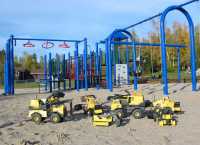
|
| In
the fall of 2002, I was invited to St. Patrick High School in
Yellowknife to talk about how I became a writer, and to discuss my
story “The Prospector’s Trail,” which was republished in
Imprints 11, a textbook for – you guessed it – Grade 11
students. Here are some of the questions the students asked, along
with my answers. (Many of which are much improved, now that I’ve
had time to think about them!) |
 |
Where did you get the idea for
“The Prospector’s Trail?” |
 |
Several years ago, I met a young
woman who had moved to Yellowknife with her husband. They had just
finished university degrees, and had decided to come north to start
their careers. It was not easy to find work – or housing – in
Yellowknife at that time, so they lived in a tent at Fred Henne
Territorial Park. I thought they were incredibly brave – I like a roof
over my head, and nice solid walls around me. Their situation was the
starting point for my story. I’d like to make it clear,
however, that I just borrowed their situation. None of the characters
in “The Prospector’s Trail” are based on my friend . . . or anyone
else, for that matter. I just made them up to suit the purposes of my
story.
Although it’s now much easier to find work in Yellowknife, a
housing shortage means that people are still living at the campsite in
the summer. Here's a
story from Northern News Services Ltd. |
 |
Have you ever gone “prospecting” at
the Yellowknife dump? |
 |
I have been to the Yellowknife dump
exactly once, when I was researching “The Prospector’s Trail.” That’s
how I got the idea for the computers, in fact – I found quite a pile
of them. I have drawn heavily on stories told by friends, which are
plentiful, since “shopping” at the dump is a well-established
tradition in Yellowknife. One of my friends gets all his supplies for
the annual Ugly Truck and Dog Contest at the dump, but that’s
another story. |

Here's another
example of the riches of the Yellowknife dump. These toy trucks,
collected at the dump, now reside at a neighbourhood park so the kids
can muck around in all that fabulous sand. |
|
|
An anecdote told by another friend inspired the
incident in which one of the denizens of the dump peers into the back
of Norman’s van and demands to know when he’s going to unload his
belongings. (Which he intends to keep, of course.)
My friend was
moving away from Yellowknife and had gotten rid of as much furniture
as possible through garage sales and classified ads. He loaded the
rest in his truck and set out for the dump. On the road in, he passed
two vehicles. Glancing in the rear-view mirror, he saw them pull
U-turns and race back toward him. The poor man didn’t even get a
chance to unload before three or four guys swarmed the back of his
half-ton, making snarky comments about the quality of the goods and the speed of
the “service.” |
 |
What is the significance of the red
plaid shirt? |
 |
Hmmm. That sounds like an excellent
essay topic, and I wouldn’t want to deprive you of the opportunity to
exercise your critical thinking skills.
( Seriously
though, don’t worry about what I had in mind when I developed the
symbol of the red shirt. What’s important is how you, as a reader,
believe it works in the story and how it supports the main theme. |
 |
Are there any other important
symbols in “The Prospector’s Trail?” |
 |
If you’re looking for an essay topic,
you might want to dig up one of those what-to-call-your-baby books,
and find the names of the main characters. You could compare the
meaning of their names with how the characters behave in the story.
The significance of Norman’s name might require some extra research,
but an encyclopedia will help. Here’s another idea. During their
second meeting at the campground, Norman kicks at a chunk of rock,
which Roy identifies as fool’s gold. You might want to consider if
there are any figurative examples of fool’s gold in the story. For
instance, what kind of “gold” is Norman seeking when he first arrives
in Yellowknife? How does this change by the end of the story? How does
his relationship with Roy affect his perspective of what’s valuable? |
 |
Have you always lived in the
Northwest Territories? |
 |
No – I was born and raised on the
Prairies. For the details, please check my biography. |
 |
Who is your favourite author? |
 |
I have two favourites. The first is
Jane Austen, who lived in England from 1775 to 1817. Jane Austen wrote
in a style known as “comedy of manners,” which pokes fun at the
conventions of society and how people navigate their way through the
obstacles society imposes. My other favourite author is Margaret
Laurence, who – like me – was born in Manitoba. Miss Laurence, who
lived from 1926 to 1987, wrote a number of novels and short stories
centred on an imaginary Manitoba town called Manawaka. It was through
these works that I first saw how a writer could capture the spirit of
a particular place and time. |
 |
Are you a full-time fiction writer? |
 |
No, unfortunately. During the day I work for the government; I write
fiction at night. |
 |
Do you have a book published? |
 |
Yes!
Borealis Press of Ottawa
has published The Ugly Truck and Dog Contest and Other Tales of
Northern Life. It is available
online. |
Copyright © Cathy Jewison, 2008. All
rights reserved |

